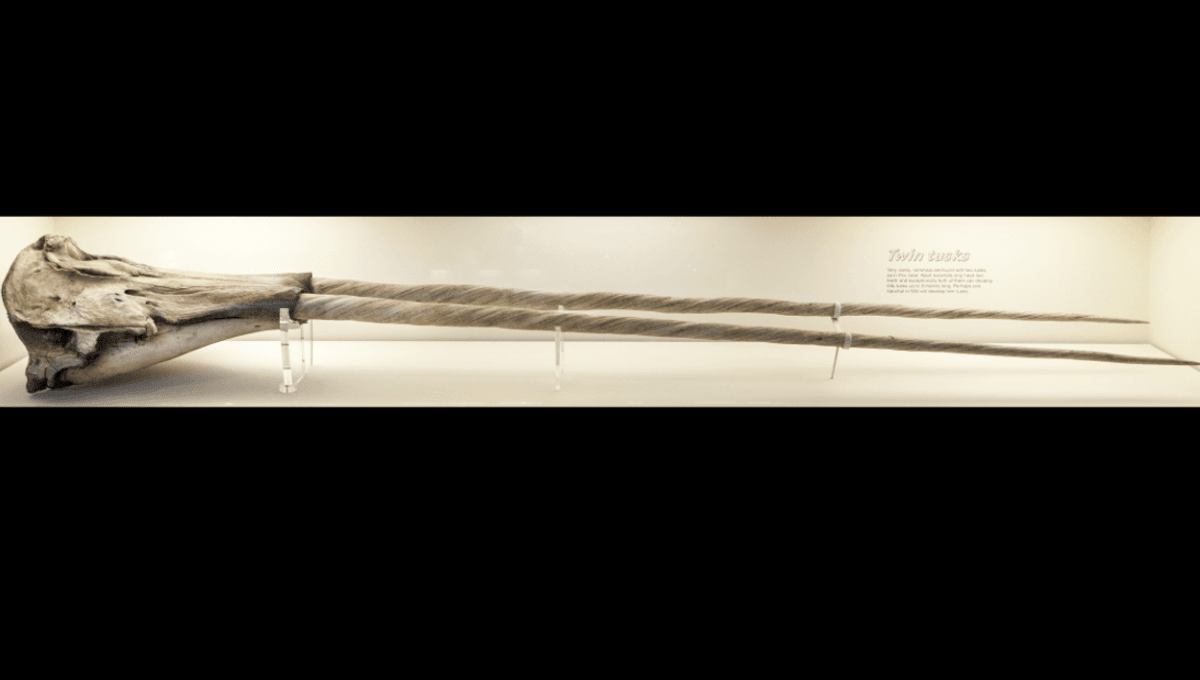
Narwhals are up there with the most fascinating creatures on the planet. These curious cetaceans have been compared by some to unicorns of the sea for the famous (and somewhat mysterious) tusk that sticks out from the center of their heads like a giant horn. Thing is, sometimes narwhals sprout two of them.
Double-tusked narwhals
A narwhal with two tusks is far from the norm, but one such specimen is housed at the London Natural History Museum, where Principal Curator for Mammals Richard Sabin overseas the life sciences department. With a rich knowledge of cetaceans, we caught up with Sabin to find out more about what’s going on with these double-tusked narwhals.
“Double tusked narwhals are extremely uncommon,” he told IFLScience. “Both male and female narwhals possess two maxillary canine teeth inside their skull and whilst females do very occasionally grow a tusk, it’s most common for these to emerge in males on the left-hand side as a long, single spiralling tusk.”
Yes, the narwhal tusk is really just a big extended tooth, and by extended we mean it can grow to up to 3 meters (9.8 feet) long. In most cases, it’s only the males who see one of these massive teeth erupt out to become a unicorn-like sword atop their heads, but sometimes they grow two, and sometimes the odd female sprouts a tusk too.
As for what drives this curious dental display? Well, that’s something we’re still trying to work out.
What do narwhals use their tusks for?
“This is still a topic of much debate and there’s still a lot of observational behavioural data to collect which will continue to enhance our understanding,” said Sabin. “A very comprehensive study was published in 2020 (Biology Letters, Zackary Graham et al), which suggested that the narwhal tusk ‘is a sexually selected signal that is used during male-male contests.’”
“The outer layer of a narwhal tusk does contain a huge quantity of nerve endings that some researchers have suggested gives narwhals a sensory ability to detect changes in the surrounding water (things like changes to temperature and pressure).”
In early 2025, the world was gifted some remarkable new footage that actually captured some tusk-use in action.
Narwhals were spotted chasing large fish, such as Arctic char (Salvelinus alpinus), and using their tusk to hit and stun the prey. They also used the tusks in interactions with seabirds, like glaucous gulls (Larus hyperboreus), which were attempting to snatch their hard-earned prey. There were also competitive interactions between narwhals as they blocked each other from the same prey, so clearly as gigantic novelty teeth go, the narwhal tusk is a multi-faceted bit of kit.
They’re also curious animals for their genes as they have remarkably low genetic diversity, making the fact they’re thriving something of a mystery. Some truly intriguing creatures, then, and ones that Sabin says are a great example of the remarkable nature of cetaceans as a group.
“What do I find most fascinating about narwhals? The same thing I find fascinating about all cetaceans – that they returned to the ocean from the land and developed a hugely diverse range of anatomical, social and behavioural adaptations, that allow them to exist in an aquatic environment,” he said. “Cetaceans are a key part of ocean ecosystems.”
And if you’ve ever wondered why you’ve never seen them in an aquarium, turns out it’s with very good reason. That said, out in the wild you just might be lucky enough to spot a narluga hybrid.
Source Link: Did You Know That Some Narwhals Have Two Tusks? It’s Rare, But It Happens